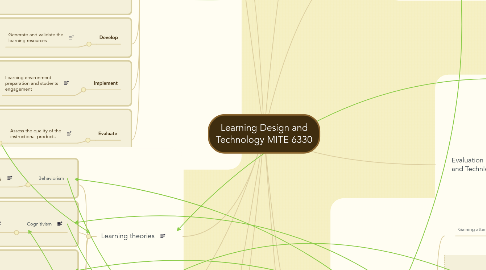
1. Instructional design theories (blended)
1.1. What is Instructional Design?
1.1.1. Origins of Instructional Technology: World War II – 1940s to 1950s (key people: Robert Gagne, Leslie Briggs, John Flanagan)
1.1.2. It is a system of procedures for developing education and training programmes in a systematic fashion
1.2. Introduction of Instructional designers
1.3. Instructional materials
2. ADDIE model
2.1. Analyze
2.1.1. Define the problems and identify the outcome
2.1.1.1. Is it a "Can't do" or "Won't do" problem?
2.1.1.1.1. Mager & Pipe's rather morbid test
2.1.1.2. Contextual analysis
2.1.1.2.1. With prior knowledge or prerequisite knowledge
2.1.1.3. Task analysis
2.1.1.3.1. Clarify the conditions needed for competent performance and construct hierarchical task diagram
2.1.1.4. Learner analysis
2.1.1.4.1. What are the most important features about our learners ?
2.2. Design
2.2.1. Verify the desired performances and testing methods
2.2.1.1. Create Storyboard
2.2.1.1.1. Advantage: It allows the designer to experiment with changes in the sequence before the production begins.
2.2.1.1.2. Disadvantage: However I believe the disadvantage of storyboard limits the products to be very linear.
2.2.1.2. Create prototype
2.2.1.3. Design user interface
2.2.1.4. Suggest learning activities
2.2.1.5. Apply instructional strategies and learning theories
2.3. Develop
2.3.1. Generate and validate the learning resources
2.4. Implement
2.4.1. Learning environment preparation and students engagement
2.5. Evaluate
2.5.1. Assess the quality of the instructional products
2.5.1.1. Formative evaluation
2.5.1.2. Summative Evaluation
3. Learning theories
3.1. Behaviorism
3.1.1. Learning as response strengthening
3.1.1.1. Teaching method: Drilling , practicing basic skills
3.2. Cognitivism
3.2.1. Learning as information processing
3.2.1.1. Teaching method: learning by finishing academic tasks, experiencing, discovering , exploring problems
3.3. Constructivism
3.3.1. Learning as social negotiation
3.3.1.1. Teaching method: Collaboration , knowledge building , inquiries and problem solving
3.4. Other readings & Reference
4. Learning objectives
4.1. Audience
4.1.1. identify and clarify the audience
4.2. Behaviour
4.2.1. Define the "level" of learning
4.3. Conditions
4.3.1. At the time of the test or performance
4.4. Degree
4.4.1. Set achievement standards
5. Other Instructional design models and examples
5.1. 7 Principles of Good Practice in Undergraduate Eduaction
5.2. Dick and Carey Model
5.3. Kemp's Instructional Design Model
5.4. Bloom's Learning Taxonomy
5.5. Kirkpatrick's 4 Levels of Training Evaluation
5.6. Cathy Moore's Action Mapping
5.7. ASSURE Model
5.8. WATER Model
5.9. KEMP design model
6. Summary & Reflection
7. Merrill' first principles of instruction
7.1. Activation
7.2. Application
7.3. Demostration
7.4. Integration
7.5. Problem
7.5.1. Well-Structured
7.5.1.1. All elements of the problems presented to learners
7.5.2. Ill-structured
7.5.2.1. Possess unknown problem elements
8. Gagne's 9 Events of Instructional Design
8.1. Gaining attention
8.1.1. Draw learner's attention via images or short video clips
8.2. Informing learner of lesson objective
8.2.1. Telling learner what they will be able to do
8.3. Stimulating recall of prior learning
8.3.1. Recall existing knowledge & retrieve working memory
8.3.1.1. Memory boosters 2+2+2
8.4. Presenting stimuli
8.4.1. Displaying the content
8.5. Guiding learning
8.5.1. Organisation to enhance understanding
8.5.1.1. mindmap
8.6. Eliciting performance
8.6.1. Asking learning to respond
8.7. Providing informative feedback
8.7.1. Reinforcement and error correction
8.8. Assessing performance
8.8.1. Providing feedbacks
8.9. Enhancing retention and learning transfer
8.9.1. Provide practice
9. Introduction of storyboard (Gannt chart)
9.1. Number of tasks
9.2. Duration of each task
9.3. Where does each task take place
9.4. Budget
10. Evaluation on Learning Design and Technlogy
10.1. 4 Levels of evaluation from Kirkpatrick , 1998
10.1.1. Level 1- Reaction
10.1.2. Level 2- Learning
10.1.3. Level 3- Behaviour
10.1.4. Level 4- Results
10.2. Bridge Evaluation Model
10.3. Alternative Approaches Evaluation
10.3.1. Stakeholders
10.3.2. Programme
10.3.3. Philosophical & Ideological Beliefs
10.3.4. Methodological Preferences
10.3.5. Practical Considerations
11. Presentation platforms
11.1. Web 2.0
11.1.1. User's focus
11.1.2. Collective Information sharing
11.2. Open Source
11.2.1. Free !
11.2.2. Flexible
11.3. Mobile 2.0
11.3.1. Interactive interfaces
11.3.2. Powerful OS's & Applications
11.3.3. Anywhere, anytime
11.3.4. Additional resources
